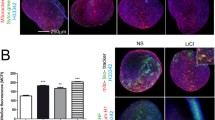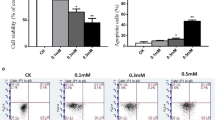Abstract
Chondrocytes in the hypertrophic zone of the growth plate undergo apoptosis during endochondral bone development via mechanisms that involve inorganic phosphate (Pi) and nitric oxide (NO). Recent evidence suggests that Pi-dependent NO production plays a role in apoptosis of cells in the resting zone as well. This study examined the mechanism by which Pi induces NO production and the signaling pathways by which NO mediates its effects on apoptosis in these cells. Pi decreased the number of viable cells based on MTT activity; the number of TUNEL-positive cells and the level of DNA fragmentation were increased, indicating an increase in apoptosis. Blocking NO production using the NO synthase (NOS) inhibitor l-NAME or cells from eNOS−/− mice blocked Pi-induced chondrocyte apoptosis, indicating that NO production is necessary. NO donors NOC-18 and SNOG both induced chondrocyte apoptosis. SNOG also upregulated p53 expression, the Bax/Bcl-2 expression ratio, and cytochrome c release from mitochondria, as well as caspase-3 activity, indicating that NO induces apoptosis via a mitochondrial pathway. Inhibition of JNK, but not of p38 or ERK1/2, MAP kinase was able to block NO-induced apoptosis, indicating that JNK is necessary in this pathway. Pi elevates NO production via eNOS in resting zone chondrocytes, which leads to a mitochondrial apoptosis pathway dependent on JNK.








Similar content being viewed by others
References
Adams CS, Shapiro IM (2002) The fate of the terminally differentiated chondrocyte: evidence for microenvironmental regulation of chondrocyte apoptosis. Crit Rev Oral Biol Med 13:465–473
Gibson G (1998) Active role of chondrocyte apoptosis in endochondral ossification. Microsc Res Tech 43:191–204
Hatori M, Klatte KJ, Teixeira CC, Shapiro IM (1995) End labeling studies of fragmented DNA in the avian growth plate: evidence of apoptosis in terminally differentiated chondrocytes. J Bone Miner Res 10:1960–1968
Ohyama K, Farquharson C, Whitehead CC, Shapiro IM (1997) Further observations on programmed cell death in the epiphyseal growth plate: comparison of normal and dyschondroplastic epiphyses. J Bone Miner Res 12:1647–1656
Mansfield K, Rajpurohit R, Shapiro IM (1999) Extracellular phosphate ions cause apoptosis of terminally differentiated epiphyseal chondrocytes. J Cell Physiol 179:276–286
Mansfield K, Teixeira CC, Adams CS, Shapiro IM (2001) Phosphate ions mediate chondrocyte apoptosis through a plasma membrane transporter mechanism. Bone 28:1–8
Teixeira CC, Mansfield K, Hertkorn C, Ischiropoulos H, Shapiro IM (2001) Phosphate-induced chondrocyte apoptosis is linked to nitric oxide generation. Am J Physiol Cell Physiol 281:C833–C839
Rajpurohit R, Mansfield K, Ohyama K, Ewert D, Shapiro IM (1999) Chondrocyte death is linked to development of a mitochondrial membrane permeability transition in the growth plate. J Cell Physiol 179:287–296
Teixeira CC, Costas AP, Nemelivsky Y (2007) Apoptosis of growth plate chondrocytes occurs through a mitochondrial pathway. Angle Orthod 77:129–134
Clancy RM, Rediske J, Tang X, Nijher N, Frenkel S, Philips M, Abramson SB (1997) Outside—in signaling in the chondrocyte. Nitric oxide disrupts fibronectin-induced assembly of a subplasmalemmal actin/rho A/focal adhesion kinase signaling complex. J Clin Invest 100:1789–1796
Amin AR, Abramson SB (1998) The role of nitric oxide in articular cartilage breakdown in osteoarthritis. Curr Opin Rheumatol 10:263–268
Blanco FJ, Ochs RL, Schwarz H, Lotz M (1995) Chondrocyte apoptosis induced by nitric oxide. Am J Pathol 146:75–85
van den Berg WB (2001) Lessons from animal models of osteoarthritis. Curr Opin Rheumatol 13:452–456
Roach HI (1997) New aspects of endochondral ossification in the chick: chondrocyte apoptosis, bone formation by former chondrocytes, and acid phosphatase activity in the endochondral bone matrix. J Bone Miner Res 12:795–805
Zhong M, Wike LJ, Ryaby JT, Carney DH, Boyan BD, Schwartz Z (2008) Thrombin peptide TP508 prevents nitric oxide mediated apoptosis in chondrocytes in the endochondral developmental pathway. Biochim Biophys Acta 1783:12–22
Kurnik BR, Huskey M, Hruska KA (1987) 1,25-Dihydroxycholecalciferol stimulates renal phosphate transport by directly altering membrane phosphatidylcholine composition. Biochim Biophys Acta 917:81–85
Lang F (1980) Renal handling of calcium and phosphate. Klin Wochenschr 58:985–1003
Sabbagh Y, Carpenter TO, Demay MB (2005) Hypophosphatemia leads to rickets by impairing caspase-mediated apoptosis of hypertrophic chondrocytes. Proc Natl Acad Sci USA 102:9637–9642
Anderson HC (1995) Molecular biology of matrix vesicles. Clin Orthop Relat Res 314:266–280
Shapiro IM, Boyde A (1984) Microdissection—elemental analysis of the mineralizing growth cartilage of the normal and rachitic chick. Metab Bone Dis Relat Res 5:317–326
Stadler J, Stefanovic-Racic M, Billiar TR, Curran RD, McIntyre LA, Georgescu HI, Simmons RL, Evans CH (1991) Articular chondrocytes synthesize nitric oxide in response to cytokines and lipopolysaccharide. J Immunol 147:3915–3920
Denninger JW, Marletta MA (1999) Guanylate cyclase and the NO/cGMP signaling pathway. Biochim Biophys Acta 1411:334–350
Stamler JS (1994) Redox signaling: nitrosylation and related target interactions of nitric oxide. Cell 78:931–936
Stamler JS, Hausladen A (1998) Oxidative modifications in nitrosative stress. Nat Struct Biol 5:247–249
Boyan BD, Schwartz Z, Swain LD, Carnes DL Jr, Zislis T (1988) Differential expression of phenotype by resting zone and growth region costochondral chondrocytes in vitro. Bone 9:185–194
Boyan BD, Schwartz Z, Carnes DL Jr, Ramirez V (1988) The effects of vitamin D metabolites on the plasma and matrix vesicle membranes of growth and resting cartilage cells in vitro. Endocrinology 122:2851–2860
Schwartz Z, Schlader DL, Swain LD, Boyan BD (1988) Direct effects of 1,25-dihydroxyvitamin D3 and 24,25-dihydroxyvitamin D3 on growth zone and resting zone chondrocyte membrane alkaline phosphatase and phospholipase-A2 specific activities. Endocrinology 123:2878–2884
Sylvia VL, Schwartz Z, Schuman L, Morgan RT, Mackey S, Gomez R, Boyan BD (1993) Maturation-dependent regulation of protein kinase C activity by vitamin D3 metabolites in chondrocyte cultures. J Cell Physiol 157:271–278
Boyan BD, Sylvia VL, Curry D, Chang Z, Dean DD, Schwartz Z (1998) Arachidonic acid is an autocoid mediator of the differential action of 1,25-(OH)2D3 and 24,25-(OH)2D3 on growth plate chondrocytes. J Cell Physiol 176:516–524
Sylvia VL, Schwartz Z, Del Toro F, DeVeau P, Whetstone R, Hardin RR, Dean DD, Boyan BD (2001) Regulation of phospholipase D (PLD) in growth plate chondrocytes by 24R, 25-(OH)2D3 is dependent on cell maturation state (resting zone cells) and is specific to the PLD2 isoform. Biochim Biophys Acta 1499:209–221
Schwartz Z, Shaked D, Hardin RR, Gruwell S, Dean DD, Sylvia VL, Boyan BD (2003) 1alpha, 25(OH)2D3 causes a rapid increase in phosphatidylinositol-specific PLC-beta activity via phospholipase A2-dependent production of lysophospholipid. Steroids 68:423–437
Schwartz Z, Graham EJ, Wang L, Lossdorfer S, Gay I, Johnson-Pais TL, Carnes DL, Sylvia VL, Boyan BD (2005) Phospholipase A2 activating protein (PLAA) is required for 1alpha, 25(OH)2D3 signaling in growth plate chondrocytes. J Cell Physiol 203:54–70
Shesely EG, Maeda N, Kim HS, Desai KM, Krege JH, Laubach VE, Sherman PA, Sessa WC, Smithies O (1996) Elevated blood pressures in mice lacking endothelial nitric oxide synthase. Proc Natl Acad Sci USA 93:13176–13181
Denison TA, Koch CF, Shapiro IM, Schwartz Z, Boyan BD (2009) Inorganic phosphate modulates responsiveness to 24, 25(OH)2D3 in chondrogenic ATDC5 cells. J Cell Biochem 107:155–162
Grey A, Chen Q, Callon K, Xu X, Reid IR, Cornish J (2002) The phospholipids sphingosine-1-phosphate and lysophosphatidic acid prevent apoptosis in osteoblastic cells via a signaling pathway involving Gi proteins and phosphatidylinositol-3 kinase. Endocrinology 143:4755–4763
Kasagi N, Gomyo Y, Shirai H, Tsujitani S, Ito H (1994) Apoptotic cell death in human gastric carcinoma: analysis by terminal deoxynucleotidyl transferase-mediated dUTP-biotin nick end labeling. Jpn J Cancer Res 85:939–945
Ji C, Ren F, Ma H, Xu M (2010) The roles of p38MAPK and caspase-3 in DADS-induced apoptosis in human HepG2 cells. J Exp Clin Cancer Res 29:50
Misko TP, Schilling RJ, Salvemini D, Moore WM, Currie MG (1993) A fluorometric assay for the measurement of nitrite in biological samples. Anal Biochem 214:11–16
Zhong M, Carney DH, Ryaby JT, Schwartz Z, Boyan BD (2009) Inhibition of phosphate-induced apoptosis in resting zone chondrocytes by thrombin peptide 508. Cells Tissues Organs 189:56–59
McMillan J, Fatehi-Sedeh S, Sylvia VL, Bingham V, Zhong M, Boyan BD, Schwartz Z (2006) Sex-specific regulation of growth plate chondrocytes by estrogen is via multiple MAP kinase signaling pathways. Biochim Biophys Acta 1763:381–392
Hoffmann J, Haendeler J, Aicher A, Rossig L, Vasa M, Zeiher AM, Dimmeler S (2001) Aging enhances the sensitivity of endothelial cells toward apoptotic stimuli: important role of nitric oxide. Circ Res 89:709–715
Bartek J, Iggo R, Gannon J, Lane DP (1990) Genetic and immunochemical analysis of mutant p53 in human breast cancer cell lines. Oncogene 5:893–899
Chipuk JE, Maurer U, Green DR, Schuler M (2003) Pharmacologic activation of p53 elicits Bax-dependent apoptosis in the absence of transcription. Cancer Cell 4:371–381
Hurst-Kennedy J, Boyan BD, Schwartz Z (2009) Lysophosphatidic acid signaling promotes proliferation, differentiation, and cell survival in rat growth plate chondrocytes. Biochim Biophys Acta 1793:836–846
Cherng YG, Chang HC, Lin YL, Kuo ML, Chiu WT, Chen RM (2008) Apoptotic insults to human chondrocytes induced by sodium nitroprusside are involved in sequential events, including cytoskeletal remodeling, phosphorylation of mitogen-activated protein kinase kinase kinase-1/c-Jun N-terminal kinase, and Bax-mitochondria-mediated caspase activation. J Orthop Res 26:1018–1026
Wang H, Wang Z, Chen J, Wu J (2007) Apoptosis induced by NO via phosphorylation of p38 MAPK that stimulates NF-kappaB, p53 and caspase-3 activation in rabbit articular chondrocytes. Cell Biol Int 31:1027–1035
Strniskova M, Barancik M, Ravingerova T (2002) Mitogen-activated protein kinases and their role in regulation of cellular processes. Gen Physiol Biophys 21:231–255
Acknowledgments
This research was funded by a grant from Children’s Healthcare of Atlanta. The authors thank Ms. Sharon Hyzy for her assistance in preparing the manuscript.
Author information
Authors and Affiliations
Corresponding author
Additional information
The authors have stated that they have no conflict of interest.
Rights and permissions
About this article
Cite this article
Zhong, M., Carney, D.H., Jo, H. et al. Inorganic Phosphate Induces Mammalian Growth Plate Chondrocyte Apoptosis in a Mitochondrial Pathway Involving Nitric Oxide and JNK MAP Kinase. Calcif Tissue Int 88, 96–108 (2011). https://doi.org/10.1007/s00223-010-9433-5
Received:
Accepted:
Published:
Issue Date:
DOI: https://doi.org/10.1007/s00223-010-9433-5




